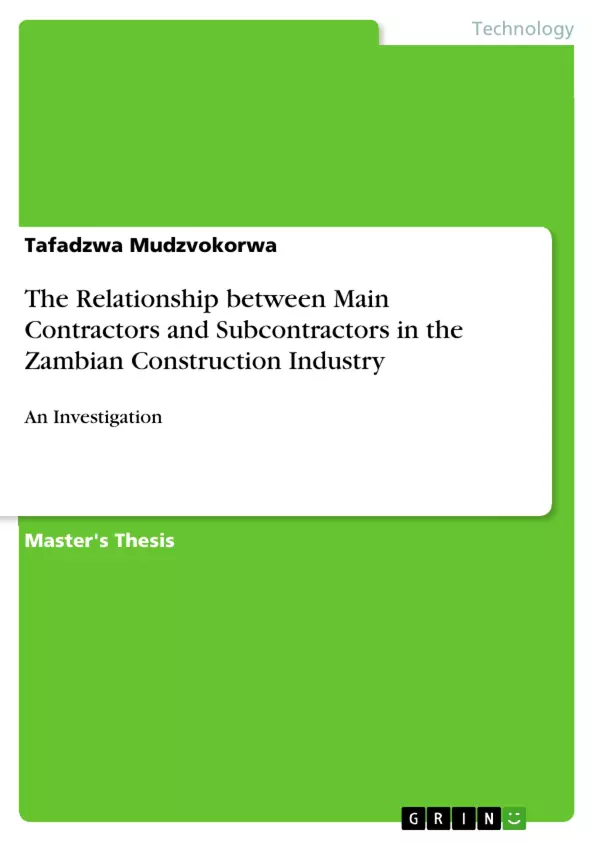In recent years there have been a substantial number of projects conducted in the Zambian construction industry. Due to the magnitude and complexity of many of these projects, contractors have resorted to subcontracting to share responsibilities and mitigate project risks. The Zambian government has also invigorated the practice of subcontracting in the construction industry as it plays an important role in increasing economy viability and building capacity. Instead of improving project success, subcontracting can act as a catalyst for poor project outcomes. Though there are many reasons that contribute to problems from subcontracting, a poor relationship between main contractors and subcontractors can be seen as a notorious contributor affecting construction works.
The study aimed at investigating the relationship between the main contractors and subcontractors in the Zambian construction industry and recommend a framework that can be implemented to better the relationship. The study also examined the effects of a poor interface between main contractors and subcontractors in Zambia. Data collection techniques used included literature review, interviews and questionnaire surveys. The relative importance index was used to determine the ranking of the results of the study. Using the results adduced from the study a main contractor-subcontractor non-contractual partnering model was developed.
The study established that the relationship between main contractors and subcontractors in Zambia is poor therefore needing attention. Interface problems were caused by payment issues, poor communication, unexpected price escalations and poor construction work. In order to address interface problems, the study found that there was need for better communication between the parties, timely payments and subcontractors’ access to labour and machinery. However, the study, had some limitations that need consideration when interpreting the results found. The limitations included scarcity of specific literature on subcontracting in the Zambian construction industry, the size of the sample only being limited to Lusaka. Nevertheless, these limitations could be addressed through further studies.
Inhaltsverzeichnis (Table of Contents)
- CHAPTER 1: INTRODUCTION
- 1.1. Background
- 1.2. Problem statement
- 1.3. Research questions
- 1.4. Aim of the study
- 1.4.1. Specific objectives
- 1.5. Importance of the study.
- 1.6. Brief research methodology ..
- 1.7. Organisation of the dissertation.....
- 1.8. Chapter summary...
- CHAPTER 2: LITERATURE REVIEW
- 2.1. Introduction
- 2.2. Subcontracting
- 2.2.1. Types of subcontractors
- 2.2.2. Selection of subcontractors
- 2.3. Subcontracting in the Zambian construction sector
- 2.3.1. 20% subcontracting policy..
- 2.3.2. Types of subcontractors
Zielsetzung und Themenschwerpunkte (Objectives and Key Themes)
The study aimed to investigate the relationship between main contractors and subcontractors in the Zambian construction industry and recommend a framework to improve this relationship. The research also examined the negative effects of a poor interface between these parties in Zambia.
- Relationship between main contractors and subcontractors in Zambia
- Factors contributing to a poor interface between main contractors and subcontractors
- Framework for improving the relationship between main contractors and subcontractors
- Effects of a poor interface on construction projects in Zambia
- Recommendations for addressing interface problems in the construction industry
Zusammenfassung der Kapitel (Chapter Summaries)
Chapter 1: Introduction provides an overview of the research, outlining the background, problem statement, research questions, objectives, importance, methodology, and organization of the dissertation.
Chapter 2: Literature Review explores the concept of subcontracting, including its various types, selection processes, and application within the Zambian construction sector, specifically focusing on the 20% subcontracting policy and the types of subcontractors prevalent in the industry.
Schlüsselwörter (Keywords)
The study focuses on the Zambian construction industry, examining the relationship between main contractors and subcontractors. Key themes include subcontracting, partnering, interface problems, payment issues, communication, price escalations, construction work, and the development of a non-contractual partnering model.
- Arbeit zitieren
- Tafadzwa Mudzvokorwa (Autor:in), 2016, The Relationship between Main Contractors and Subcontractors in the Zambian Construction Industry, München, GRIN Verlag, https://www.grin.com/document/369925



